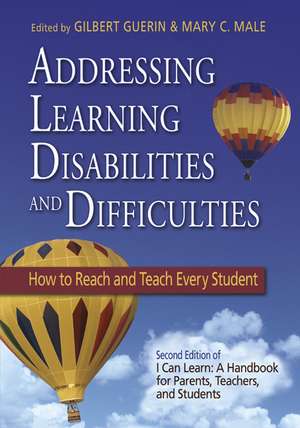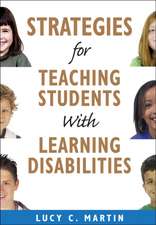Addressing Learning Disabilities and Difficulties: How to Reach and Teach Every Student
Editat de Gilbert Guerin, Mary C. Maleen Limba Engleză Paperback – feb 2006
The book covers:
o Distinguishing learning difficulties from learning disabilities;
o General screening strategies for specific learning disabilities (so students can be referred to specialist for further testing);
o Specific strategies to improve learning skills such as listening comprehension, attention span, retention and retrieval of material, mathematical reasoning, reading comprehension and more;
o Numerous strategies to improve performance skills such as verbal expression, spelling, test taking and more;
o Classroom management strategies for the inclusive classroom;
o Overview of referral and evaluation procedures;
o Components of a successful individualized education programmes (IEPs);
o Discussion of program options, service delivery models, and strategies and programs for school sites (such as peer tutoring, service learning and collaborative staff development);
o Glossary of Special Education terms;
o Agencies, organizations and websites for further research.
| Toate formatele și edițiile | Preț | Express |
|---|---|---|
| Paperback (1) | 281.85 lei 6-8 săpt. | |
| SAGE Publications – feb 2006 | 281.85 lei 6-8 săpt. | |
| Hardback (1) | 522.66 lei 6-8 săpt. | |
| SAGE Publications – 10 apr 2006 | 522.66 lei 6-8 săpt. |
Preț: 281.85 lei
Nou
Puncte Express: 423
Preț estimativ în valută:
53.94€ • 55.72$ • 44.89£
53.94€ • 55.72$ • 44.89£
Carte tipărită la comandă
Livrare economică 25 martie-08 aprilie
Preluare comenzi: 021 569.72.76
Specificații
ISBN-13: 9781412925624
ISBN-10: 1412925622
Pagini: 184
Dimensiuni: 178 x 254 x 12 mm
Greutate: 0.39 kg
Ediția:1
Editura: SAGE Publications
Colecția Corwin
Locul publicării:Thousand Oaks, United States
ISBN-10: 1412925622
Pagini: 184
Dimensiuni: 178 x 254 x 12 mm
Greutate: 0.39 kg
Ediția:1
Editura: SAGE Publications
Colecția Corwin
Locul publicării:Thousand Oaks, United States
Recenzii
"This quick reference reflects 2004 amendments to the Individuals with Disabilities Education Act (IDEA) and recent developments for working with children and youth with learning disabilities and learning differences."
—From the Preface
—From the Preface
Cuprins
Preface
Acknowledgments
About the Editors
1. Introduction
Some Background of Difficulties With Children’s Learning and Performance
Complexity of Learning and Performance Difficulties
Basic Assumptions
Approaches to Children’s Difficulties in Learning and Performance
Uses, Benefits, and Limitations of Addressing Learning Disabilities and Difficulties
Parts I and II: Their Content and Purpose
Ways to Use This Handbook
Summary
Part I: Learning Difficulties and Teaching Strategies
2. Strategies to Improve Learning Skills
Listening Comprehension
Ability to Pay Attention
Organizational Skills
Retention and Retrieval of Material
Productivity
Mathematical Computations and Operations
Mathematical Reasoning and Problem Solving
Reading Word Recognition
Reading Comprehension
Summary
Intervention Plan
3. Strategies to Improve Performance Skills
Verbal Expression
Handwriting and Copying
Spelling
Written Expression
Test Taking
Appropriate Social Behavior
Summary
Intervention Plan
Part II: The Special Education Referral Process
4. Referral and Eligibility
Documentation of Adaptations
The Referral Process
The Evaluation Process
Parents’ Rights
Eligibility and Specific Learning Disabilities
Summary
5. The Individualized Education Program
Intent of the IEP
IEP Meeting
Content of the IEP Document
The Positive Behavioral Intervention Plan
Placement in Alternative Education Setting
Reviews and Reevaluations
Summary
6. Options for Service Delivery
Continuum of Program Options
Service Delivery Models
Strategies and Programs for School Sites
Summary
Afterword
Glossary
Resource A: Characteristics and Criteria for Identifying Students With Learning Disabilities, Dyslexia, Attentional Disorders, and Behavioral Problems
Resource B: Selected Internet Sites
Resource C: Agencies and Organizations
Selected References
Index
Acknowledgments
About the Editors
1. Introduction
Some Background of Difficulties With Children’s Learning and Performance
Complexity of Learning and Performance Difficulties
Basic Assumptions
Approaches to Children’s Difficulties in Learning and Performance
Uses, Benefits, and Limitations of Addressing Learning Disabilities and Difficulties
Parts I and II: Their Content and Purpose
Ways to Use This Handbook
Summary
Part I: Learning Difficulties and Teaching Strategies
2. Strategies to Improve Learning Skills
Listening Comprehension
Ability to Pay Attention
Organizational Skills
Retention and Retrieval of Material
Productivity
Mathematical Computations and Operations
Mathematical Reasoning and Problem Solving
Reading Word Recognition
Reading Comprehension
Summary
Intervention Plan
3. Strategies to Improve Performance Skills
Verbal Expression
Handwriting and Copying
Spelling
Written Expression
Test Taking
Appropriate Social Behavior
Summary
Intervention Plan
Part II: The Special Education Referral Process
4. Referral and Eligibility
Documentation of Adaptations
The Referral Process
The Evaluation Process
Parents’ Rights
Eligibility and Specific Learning Disabilities
Summary
5. The Individualized Education Program
Intent of the IEP
IEP Meeting
Content of the IEP Document
The Positive Behavioral Intervention Plan
Placement in Alternative Education Setting
Reviews and Reevaluations
Summary
6. Options for Service Delivery
Continuum of Program Options
Service Delivery Models
Strategies and Programs for School Sites
Summary
Afterword
Glossary
Resource A: Characteristics and Criteria for Identifying Students With Learning Disabilities, Dyslexia, Attentional Disorders, and Behavioral Problems
Resource B: Selected Internet Sites
Resource C: Agencies and Organizations
Selected References
Index
Descriere
This updated edition of I Can Learn offers the best practices and policies that enable students with learning disabilities to excel in the general education classroom.















